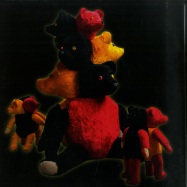Charlemagne Palestine
AA SSCHMMETTRROO SSPPECCTIVVE LP
12 Inch



Published on the occasion of Charlemagnes AA-SSCHMMETTRROOSSPPECCTIVVE exhibition, audioMER. is proud to present historical piano recordings dating from circa 1974.They were played on a Bösendorfer model 220, regarded by some as the Rolls Royce of pianos, at Charlemagnes 64 North Moore Street studio, Tribeca in New York.
Sales Information:
Composer, musician, visual artist and performer, Charlemagne Palestine is a legendary figure in the New York underground scene. At the piano or on his electronic oscillators, this outsider of skilful music experiments with the principles of resonance and repetition in a quest for the golden sound: the ultimate harmonic vibration. Based in Brussels for 20 years now, his iconic work consisting of teddy bears, divinities and other enchanting encounters is now exhibited in BOZAR (AA SSCHMMETTRROOSSPPECCTIVVE, 18 May 26 August 2018). For the occasion, Charlemagne Palestine also presents two exceptional musical performances at the Kunstenfestivaldesarts.
Published on the occasion of Charlemagnes AA-SSCHMMETTRROOSSPPECCTIVVE exhibition, audioMER. is proud to present historical piano recordings dating from circa 1974. They were played on a Bösendorfer model 220, regarded by some as the Rolls Royce of pianos, at Charlemagnes 64 North Moore Street studio, Tribeca in New York.
The music here represents Charlemagnes infamous strumming technique, which he describes himself in a 2002 interview with Perfect Sound Forever as follows: My first piano music resembles impressionists like Debussy or Ravel but its played through four or five hours, including some little arpeggios and played over and over again in thousands of different ways Later on, I began to see that Id played the piano like a flamenco guitar, that many overtones could change and the music that came out had a density and verticality thanks to the overtones which was extraordinary.
Together with the book this vinyl record celebrates the career of a prolific artist in word, image and sound. A result of an intense collaboration between the artist, BOZAR and MER. Paper Kunsthalle/audioMER.
Biography:
Charlemagne Palestine was born Chaim Moshe Palestine in Brooklyn, New York of a Jewish immigrant family from Odessa and Minsk in 1947. At six years old he started to sing traditional Jewish cantorial music in the synagogue.
At the New York University, he began composing electronic music at the NYU Electronic Music Studio run by Morton Subotnick where he worked with electronic synthesizer oscillators and filters which he would name Spectral Continuum. Later Subotnick invited him in 1969 to relocate to Los Angeles and participate in the creation of a new radical school for multimedia, arts, music, dance and theatre known as the California Institute of the Arts. There he met happening artist inventor Allan Kaprow, video pioneer Nam June Paik, avant-garde composer James Tenney, fluxus artists Emmett Williams, Dick Higgins, Alison Knowles and Judson Dance Theatre member and artist Simone Forti with whom Palestine created a unique music and dance form called Illuminations in 1970, which they have continued to perform irregularly over the last 45+ years even just recently at Centre Pompidou, Paris and MoMA, New York. At Cal Arts he developed many different practices: electronic and acoustic sound works, body performance art, video art and multimedia installations. With Forti he was invited for the first time to Europe to perform in a festival in Rome in 1972 where he met La Monte Young, Philip Glass, Steve Reich and Terry Riley. With his revolutionary solo piano work Strumming Music, he was included in the new musical trend known as Minimal Music.
In 1974 Karel Geirlandt and Hergé come from Brussels to visit his studio in Soho, New York, and invite him to inaugurate Geirlandts recent appointment as director of the Centre for Fine Arts in Brussels. In November of that year Charlemagne performs a legendary 2?½ hour solo installation / concert in Horta Hall on a Viennese Bösendorfer Imperial piano surrounded by his entourage of animal toy divinities that in the early seventies began to become his trademark, sacred alter-egos that later will become a new art form in themselves. He begins to use the term CharleWorld for his total artistic presentations.
By the early eighties, he began to do less performances and videos and devoted himself to creating large stuffed animal divinity altars inspired by his earlier sacred alter-ego travel divinities and the historical iconic Teddy Bear animal toy that was invented in the same neighborhood where he was born in Brooklyn in 1902 by Rose and Morris Michtom, Jewish immigrants from the same region and background as his own grandparents. With Steiff company he built a 6 meter high GodBear/BuddhaBear outdoor sculpture in real mohair for Documenta 8 in Kassel, Germany in 1987.
In the early nineties he started to be contacted by a whole new generation of musicians (Pan Sonic, Michael Gira etc ), performers and artists (Body By Body at Levy.Delval in 2014), who convince him to come back to the international scene, after some years of retreat, and with now a new audience and new presentation opportunities he begins the next chapter in his work and life and starts again to perform and create a new Gesamtkunst, a new CharleWorld.
[txt from ]